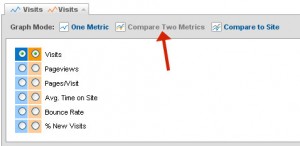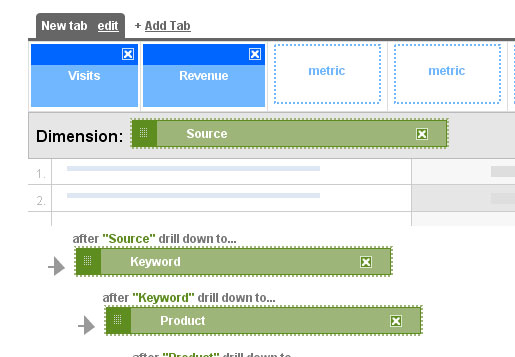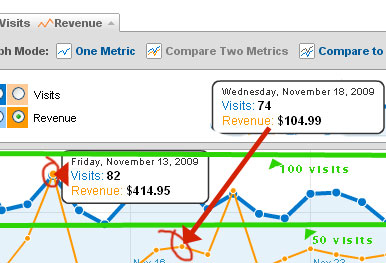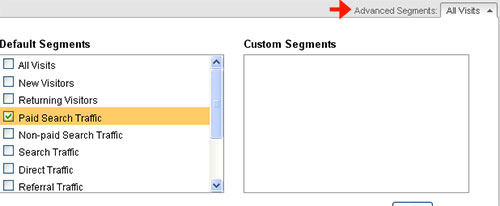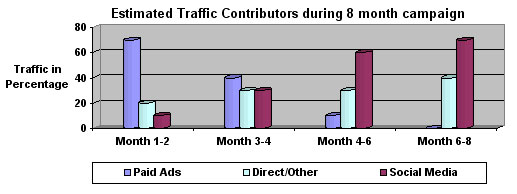Looking to phase a social media campaign into your marketing mix or trying to scale up your existing campaign?
If your site has been around for a while, chances are that you are already keeping an eye on data coming in from Google Analytics. This historical data can help lay down basic targets for your future campaigns that include social media efforts.
Here are a few steps that offer a brief outline of one such approach.
1. Deciding on Key Metrics: Find a period in time when your site generated higher revenue or showed significant achievement of other ‘goals’ (I hope you have been tracking these in Google Analytics). This will be the base period that we will use. Now decide on significant metrics that hold relevant correlation to ideal targets.
E.g.: In one campaign I chose ‘Number of Visits’ and ‘Revenue’. We decided to find out how many visits were required to reach specific daily revenue benchmarks.
The site in question, did not have a social media campaign in place and previously used paid (Google ads) and non-paid search (outsourced SEO) to generate traffic.
So in this case we were trying to find out approximately how many visitors should result from a social media campaign, in order to achieve and exceed acceptable daily revenue targets.
2. Setting Benchmarks Using Custom Reports: In order to ascertain your benchmarks, it is useful to overlay chosen metric graphs.
Depending on the metrics you have chosen in step 1, you may be able to use the ‘Compare two metrics’ option in Analytics.
As you can see above, in my case, I could not overlay Visits against Revenue so I had to create a custom report. These are very easy to set up. If you need help, refer to this article on custom reports by Bethany Bey.
I added some ‘dimensions’ like source, keyword, product etc. that I could use for broader purposes (which I skip now for the sake of brevity).
When I had the two graphs neatly overlaid, the client decided on minimal acceptable daily revenue (104.99$) that occurred in the base period. This would be our lower and minimum acceptable revenue benchmark.
The highest daily revenue (414.95$) during this period would be the higher end of our revenue benchmark. This is the number we would seek to achieve and exceed in future campaigns.
Using this segment from the base period, we looked at the maximum and minimum number of visitors during this time. We were able to deduce that the number of targeted visitors needed to achieve revenue benchmarks, would have to approximately be within 50 and 100 (numbers were rounded off).
3. Deciding Strategic approach: Now that we have the numbers we can decide what we want to focus our marketing strategy on.
Apart from increasing revenue, one of the things that this particular client wanted to do was to minimize the use of Google Ads, or phase it out completely. He felt that the minimum bid amounts were getting to be too high.
We looked at the report again to isolate the paid ad contribution to our base period in terms of traffic. Using the same methodology from step 2, we derived our benchmarks. Tip: Advanced Segments options in your reports allow you to isolate paid and non-paid traffic.
We now knew how many approximate visitors we had to bring in via our social media efforts, in order to phase out Google Ads as well as to increase revenue. Using the information we formulated an 8-month strategy to achieve these goals. The following chart provides an overview:
You could obviously use the same tactics to develop benchmarks needed to attain future targets. e.g.: to increase the revenue by two, multiply the benchmarks by the same amount.
The numbers will also indicate if your social media efforts are focused enough. E.g.: If your social media campaign regularly exceeds your benchmarks without resulting in increased revenue, your social media efforts are probably not attracting visitors who are interested enough in your products. You can fix this by revisiting your content marketing strategy and/or outreach programs.
Limitations and Progress Monitoring
One may encounter limitations with this approach when there are multiple product lines and broader sets of variable metrics across product lines. Even then, the custom reports feature can drill down to product-centric metrics to derive relevant benchmarks.
Google Analytics reports are also a great place to find keywords that visitors use and do not use to reach your site. These keywords could prove useful to your content marketing strategy mix.
Of course, you want to use Google Analytics to monitor your social media marketing efforts (thanks Paul Anthony) and progress as you continue building your online charisma.
Have you already been using your Google Analytics data to form strategies for social media efforts? Care to share your own tips? Will you find use for this approach in your own projects?


